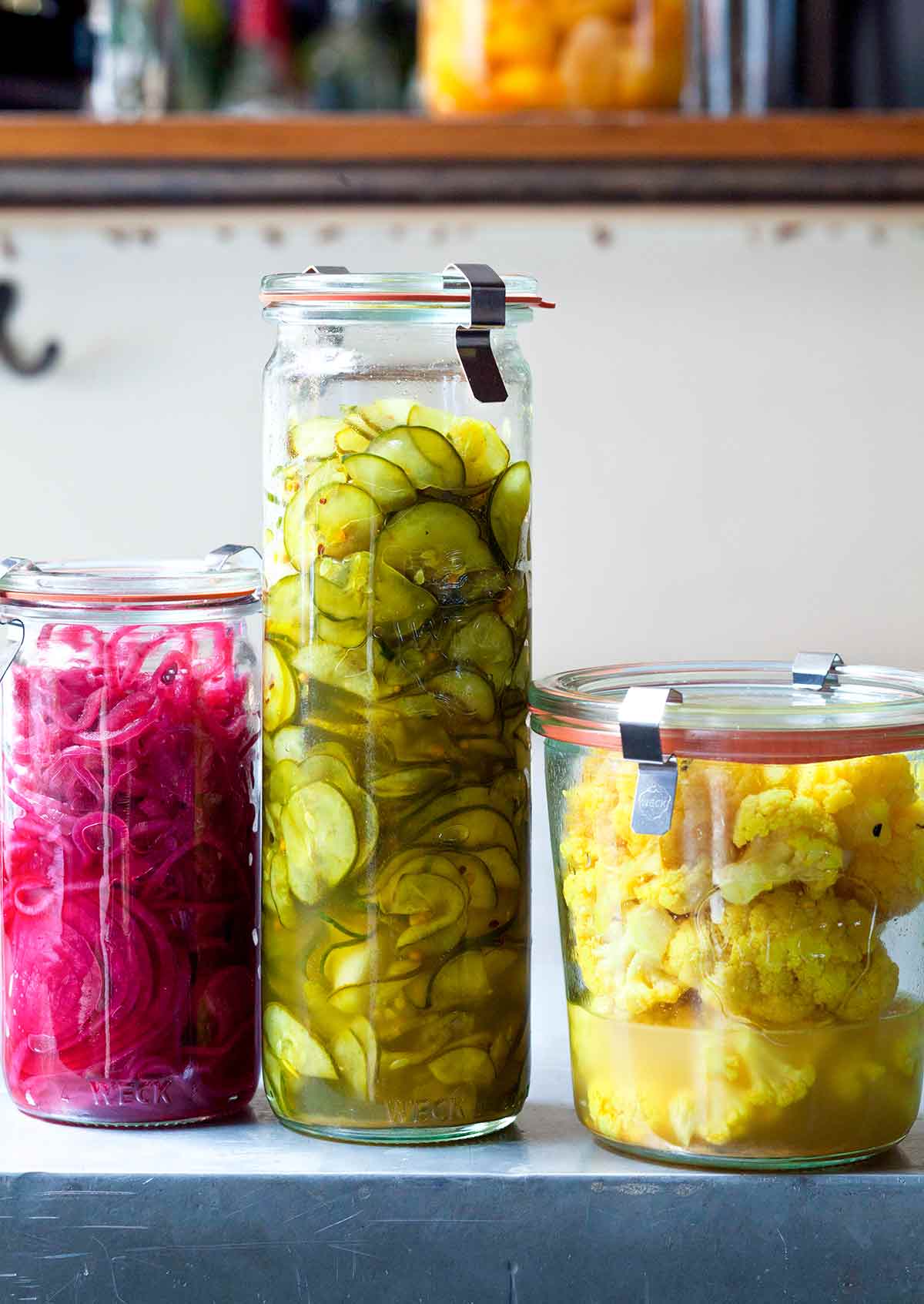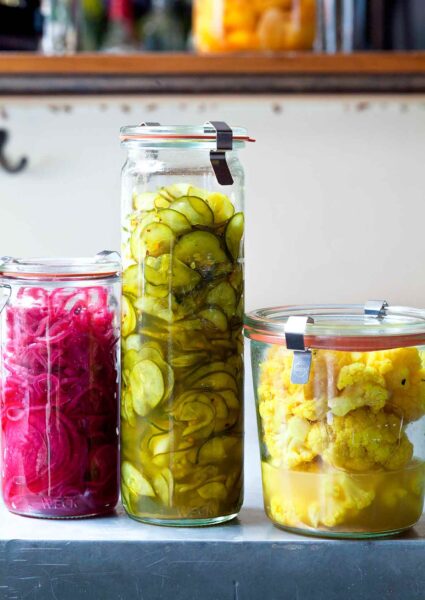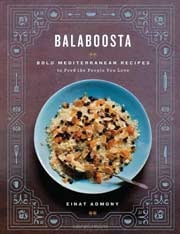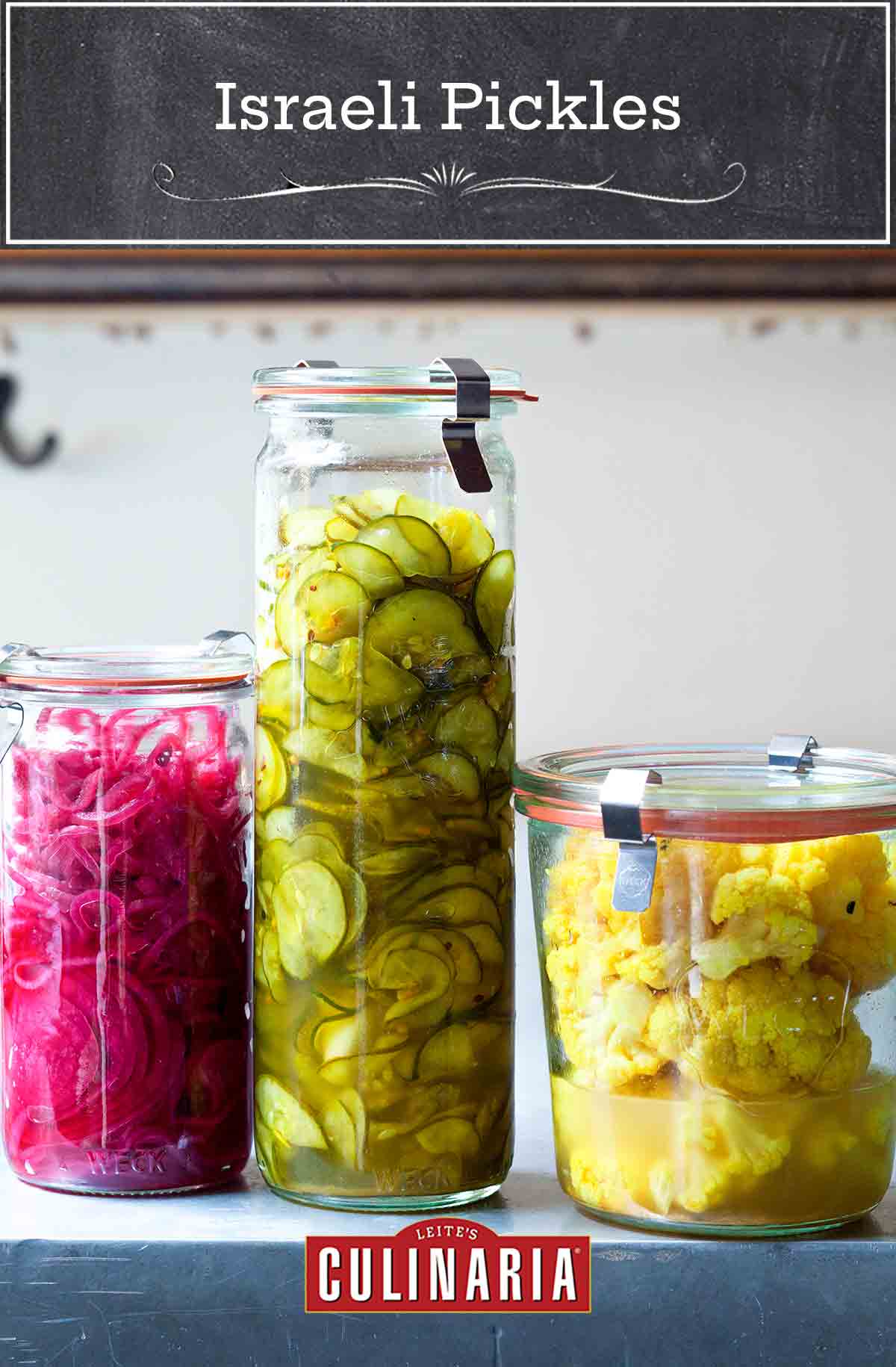
In the States, people most often think of pickled cucumbers when they hear the word pickles. But in Israel, when we say hamutzim, we refer to all the vegetables that we pickle, including cauliflower, eggplants, carrots, celery, red onions, and beets–Israeli pickles.
Pickling is a terrific way to make use of old vegetables. Before they go bad, simply pickle them instead of throwing them out. Until I learned this technique, I had no idea how delicious a pickled cherry tomato could be. [Editor’s Note: And the pickles come together in mere minutes and can be stashed in the fridge without proper canning.]–Einat Admony
Israeli Pickles FAQs
The original recipe calls for amba spice mix, which is commonly found at Indian and Middle Eastern spice emporiums or grocery stores. It contains, among other ingredients, dried mango powder and turmeric.
One of our recipe testers substituted chaat masala for the spice mix to terrific effect. She explains that “chaat” means “to lick,” and that this finger-licking spice blend is quite addictive. She makes her own chaat masala by grinding 1 tablespoon dried mango powder (amchoor or amchur), 2 teaspoons toasted cumin seeds, 2 teaspoons black salt, 1 teaspoon coarse salt, 1 teaspoon dried pomegranate seeds (anardhana), and 1/2 teaspoon whole black peppercorns.
Don’t think you have access to those ingredients? Think again. We’ve heard from many of our recipe testers that they’ve never had trouble finding unusual spices in marginally large cities, whether by tracking down ethnic stores or even, in a desperate moment, going to an Indian restaurant and asking if they’d sell you a little of this or that. Hey, can’t hurt to ask, especially if you’re already a regular there.
Stored properly, in a covered container in the refrigerator, these pickles will last for 4 to 6 weeks.

Israeli Pickles
Ingredients
For the pickled cucumbers
- 2 1/2 cups cold water
- 1 1/2 cups distilled white vinegar
- 1/2 cup granulated sugar
- 1/4 cup kosher salt
- 1 small yellow onion, thinly sliced
- 2 garlic cloves, thinly sliced
- 1 teaspoon mustard seeds
- 1/4 teaspoon ground turmeric
- 1/4 teaspoon dill seeds
- 6 to 8 Kirby cucumbers, sliced into thin rounds
For the pickled cauliflower
- 2 1/2 cups cold water
- 1 cup distilled white vinegar
- 3/4 cup granulated sugar
- 1 1/2 tablespoons chaat masala or amba spice mix
- 1 tablespoon kosher salt
- 1 pinch ground turmeric
- 1 large head cauliflower
- 1 1/2 teaspoons nigella seeds
- 1 garlic clove
For the pickled red onions
- 4 small red onions, thinly sliced
- 1 small red beet, sliced into paper-thin rounds
- 1 bay leaf
- 1 star anise
- 1 cinnamon stick
- 2 cups distilled white vinegar
- 1 cup granulated sugar
Instructions
Make the pickled cucumbers
- In a small saucepan, combine the water, vinegar, sugar, and salt. Bring to a boil and stir until the sugar is completely dissolved. Remove from the heat and let cool to room temperature.
- In a large bowl, mix the onion, garlic, mustard seeds, turmeric, dill seeds, and cucumbers together. When the vinegar mixture has cooled, pour it over the cucumbers and stir well to combine.
- Transfer the pickles to a 1-quart glass jar. Cover and stash in the back of the fridge for at least 1 week. The pickles will keep, refrigerated, for up to several weeks.
Make the pickled cauliflower
- In a small saucepan, stir together the water, vinegar, sugar, chaat masala or amba, salt, and turmeric. Bring to a boil and stir until the sugar is completely dissolved. Remove from the heat and let cool to room temperature.
- Meanwhile, trim the cauliflower into small florets and place in a 4-pint glass jar. Pour the cooled vinegar mixture into the jar and then toss in the nigella seeds and garlic. Cover and stash in the back of the fridge for at least 1 week. The pickles will keep, refrigerated, for up to several weeks.
Make the pickled red onions
- Cram the onions, beet slices, bay leaf, star anise, and cinnamon stick in a 1-quart glass jar.
- In a small bowl, whisk together the vinegar and sugar. Pour it over the jumble of onions and other ingredients in the jar. Cover and stash in the back of the fridge for at least 1 week. The pickles will keep, refrigerated, for up to several weeks.

Nutrition
Nutrition information is automatically calculated, so should only be used as an approximation.
Recipe Testers’ Reviews
All I can say about this particular style of Israeli pickles is move over dill, cause there’s a new guy in town.
I grew up in an Italian neighborhood with garlic pickles in a barrel and have grown quite fond of pickles in general. I love pickles of all kinds. I’ve had homemade pickles in so many variations, but nothing like this one. I’m not sure what the difference is; it may be the sugar. One thing for sure, these are incredible, at least to me. Not too sweet and not too tart.
These are sliced, so use them on burgers and on sandwiches, or eat a bunch plain, or you can even work them into salads or whatever. Don’t see myself buying pickles ever again, especially not the chips for burgers.
These also went over very well with my tasters and friends—so well that I have to make more. I’ll be doing some spears as well for some variety. Kirby cucumbers are also known as pickling cucumbers and can be found in most supermarkets. Try it. I promise you won’t be disappointed.
I have no comments or notes to add because this recipe is just right. Well, one thing: If you want more heat then add some red pepper flakes at your own risk.
This Israeli pickles recipe was great. My only complaint was that I prefer spears, not slices, for my pickles. So in the future, I’ll be trying this recipe by cutting the cucumbers in spears and then letting them sit in the fridge for longer (2 weeks, perhaps). The garlic definitely came through and the flavor was brine-like yet SO much better than your normal jarred pickle.
I made the cucumber and cauliflower Israeli pickles recipe about 10 days ago. Today I opened the cucumber pickle at lunch time and served it alongside roast chicken and a green salad. The cucumbers were fairly crisp and the flavors had permeated quite well. It’s certainly an easy way to make pickles during the off season.
I couldn’t find kirby cucumbers so I used mini cucumbers. The cauliflower pickle I made with chaat masala (an Indian spice blend) and I must say I enjoyed it very much. The cauliflower was a nice yellow from the turmeric and the chaat spice had permeated it quite well. The cauliflower remained crisp. I think these will make great hostess gifts.
Pickles have always been a favorite of mine, and sure enough, the final result of this Israeli pickles recipe was just like the ones I recall from growing up. The cauliflower gained a slight yellowish tint and was nice and crunchy with a delicious tart and sour taste, just as a pickled vegetable should have.
Pickles are a staple in our house, and I make tons of varieties. While these cucumber pickles didn’t cause my eyes to roll back in ecstasy, they were still good pickles. Notice “were,” denoting past tense, as they disappeared in a flash.
The pickles recipe doesn’t contain particularly interesting or unique ingredients, nothing to wow, but it turned out a good pickle with an ever-so-slight crunch. The sliced garlic added a nice mellow flavor. When I make this recipe again, I’ll add juniper berries and red pepper flakes, which is my personal preference.
I’m really happy to have found this Israeli pickles recipe. Since I don’t want to can a dozen or more jars of pickles, I don’t make them. Or, I should say, I didn’t make them. I will now.
I made it with cucumbers and it’s quick, easy, and yields very crisp pickles with nice flavors. I want to experiment with different spices to make these even more flavorful.
Tonight, a week after I made the red onions Israeli pickles recipe, I put some on my salad. The color was lovely and the pickle added some interest to the salad. It would also be good on a piece of bread with cheese or meat.
The flavor of the cinnamon, bay, and star anise isn’t noticeable enough for me. Perhaps a larger cinnamon stick, 2 star anise, and bay leaves would help.














How do you say “to pickle” in Hebrew?
We Indians say “aachar,” which means to pickle in our language.
Shubhprakash, that’s an excellent question. I’ve done some research and want to confirm with some experts so I’m going to get back to you. In the meantime, if there are any Israeli speakers out there who’d like to share how to say this, we’d love to know!
Lachmotz from “chamutz” = sour
Pickles are Chamutzim in Hebrew
Many kind thanks, Joey.
Le-Ha-ch-mitz להחמיץ the “ch” is a deep throaty sound impossible to spell in English. Note: the same word has double meaning, the 2nd meaning is to miss (an opportunity) which you can perhaps equate to the english “when things turn sour” Hebrew Listeners will know the true meaning by the context
Thanks for that, Jason!
And after perusing the cookbook, I must say that there is a lot to peruse. My only regret is that I had to return it to the library before I had a chance to get over involved… Which would be easy to do.
Abbe, that’s why they allow you to check out a book more than once!!
Do you initially cover the vegetables with the brine? If not, of if the brine level drops (as in your picture with the cauliflower) does it effect the crispness or flavor or “keeping” quality of the pickles?
Thanks – looking forward to trying this. I love all kinds of pickled veg!
Hi Quinn, yep, the vegetables are covered in brine. Let us know how Quinn’s quickles turn out!